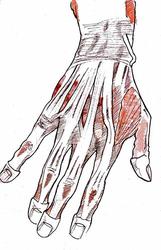 What are the extensor tendons?
What are the extensor tendons?
The extensor tendons are strong smooth cords that straighten the fingers by connecting the muscles of the forearm and hand to the bones in the fingers and thumb.
At the base of the finger, the long tendon from the forearm muscle is joined by the short tendons from the small muscles in the hand to form a complicated sheet of tendon fibres over the back of the finger. This sheet has a central band that straightens the middle joint and two lateral bands that separate and join together again to straighten the end joint
The extensor tendons are just under the skin and are easily injured by any cut across the back of the wrist hand or fingers. The tendons are especially vulnerable where the cut is over the back of the joints of the fingers.
The tendons can also be torn by closed injuries such as stubbing the finger, usually at the end joint (mallet finger) or at the middle joint (boutonnière deformity).
What are the signs of an extensor tendon injury?
A cut across the back of the wrist, hand or finger.
Inability to fully straighten the finger or thumb.
The finger or thumb drooping downwards
Pain on trying to straighten the finger or thumb.
A hand surgeon will test the tendons to ascertain their integrity and decide if a repair is needed. X-rays may be taken if the injury was caused by glass or if damage to a joint is suspected. Occasionally, ultrasound or MR scans are needed to give more information about the tendon.
What is the treatment?
Tendon repair. Most cut tendons need surgical repair, although partly cut tendons can heal well with splintage or with gentle exercise in some cases.
The repair may be performed under local anaesthetic, general anaesthetic or regional anaesthetic (injection of local anaesthetic at the shoulder). The wound is enlarged so that the cut ends of the tendon can be found and held together with stitches. At the end of the operation the hand and forearm are immobilised in a plaster splint that is placed over the bandages, in order to protect the repair.
Hand therapy. The hand therapist will usually replace the plaster splint with a light plastic splint and start a protected exercise programme within a few days of the operation. The therapy programme after tendon repair is crucial and at least as important as the operation itself, so it is vital to follow the instructions of the therapist closely. The objective is to keep the tendon moving gently to prevent it sticking to the surrounding tissues but to avoid breaking the repair.
The splint is usually worn for between three and six weeks, depending on the injury, after which a gradual return to hand use is allowed. However, the tendon does not regain its full strength until three months after the repair and the movement may improve slowly for up to six months.
Closed injuries of the finger tendons are usually treated with splints rather than surgery.
What is the outcome of an extensor tendon injury?
Repair of cleanly cut extensor tendons generally results in a functional finger but does not always provide full movement. The result may be less good if the injury involved crushing, loss of skin or damage to bones and joints.
Problems that can occur include:
The repair breaks. It usually happens early on as the tendon is at its softest at this stage of healing. The patient may feel a "ping" as the repair snaps or simply notices that the finger isn't moving in the way it has been. If you are concerned that your tendon repair has broken you should contact the surgical or therapy team immediately.
The tendon sticks to its surroundings. More hand therapy may help. In some cases, an operation to release the tendon from the scar tissue (tenolysis) may improve the movement, but full movement may not be regained.
All artwork:©Donald Sammut 2017